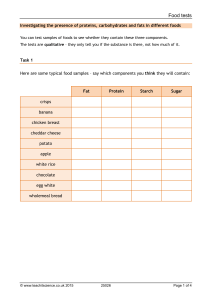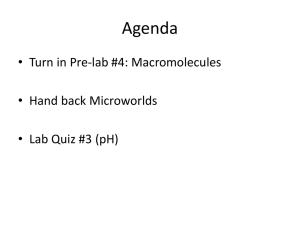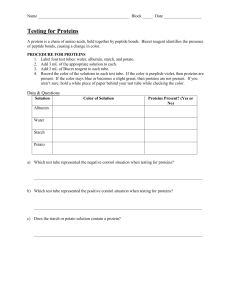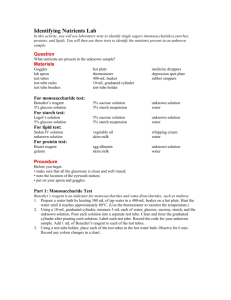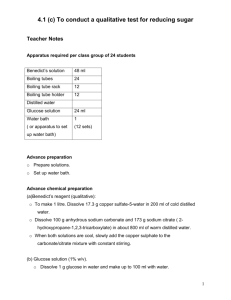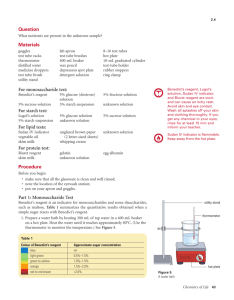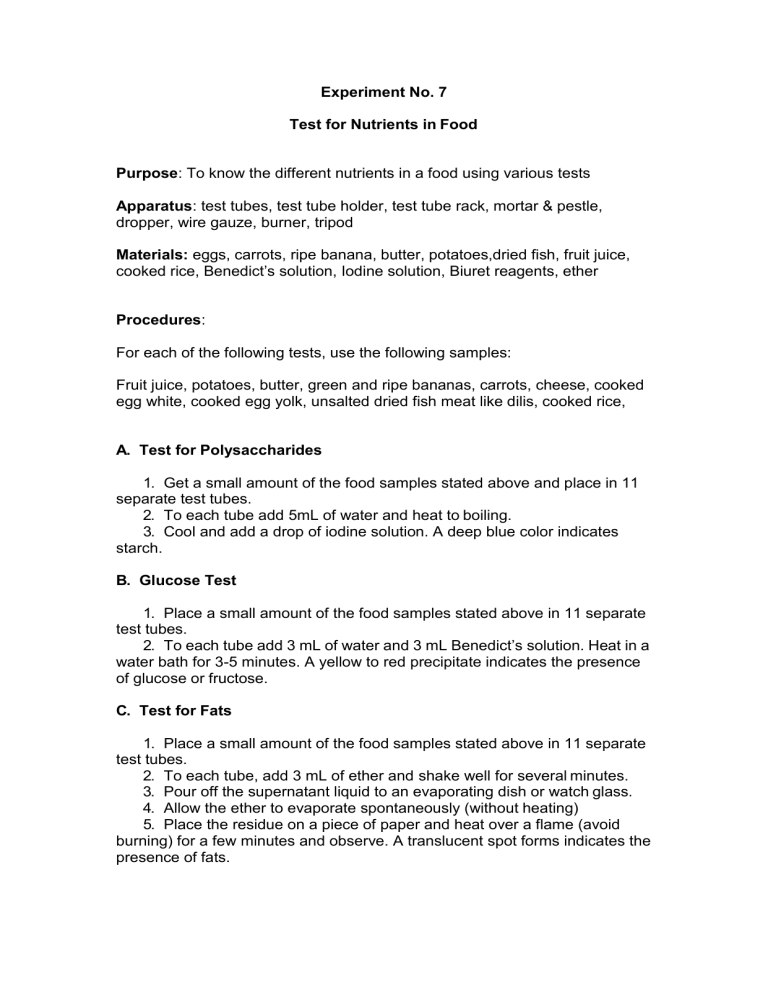
Experiment No. 7 Test for Nutrients in Food Purpose: To know the different nutrients in a food using various tests Apparatus: test tubes, test tube holder, test tube rack, mortar & pestle, dropper, wire gauze, burner, tripod Materials: eggs, carrots, ripe banana, butter, potatoes,dried fish, fruit juice, cooked rice, Benedict’s solution, Iodine solution, Biuret reagents, ether Procedures: For each of the following tests, use the following samples: Fruit juice, potatoes, butter, green and ripe bananas, carrots, cheese, cooked egg white, cooked egg yolk, unsalted dried fish meat like dilis, cooked rice, A. Test for Polysaccharides 1. Get a small amount of the food samples stated above and place in 11 separate test tubes. 2. To each tube add 5mL of water and heat to boiling. 3. Cool and add a drop of iodine solution. A deep blue color indicates starch. B. Glucose Test 1. Place a small amount of the food samples stated above in 11 separate test tubes. 2. To each tube add 3 mL of water and 3 mL Benedict’s solution. Heat in a water bath for 3-5 minutes. A yellow to red precipitate indicates the presence of glucose or fructose. C. Test for Fats 1. Place a small amount of the food samples stated above in 11 separate test tubes. 2. To each tube, add 3 mL of ether and shake well for several minutes. 3. Pour off the supernatant liquid to an evaporating dish or watch glass. 4. Allow the ether to evaporate spontaneously (without heating) 5. Place the residue on a piece of paper and heat over a flame (avoid burning) for a few minutes and observe. A translucent spot forms indicates the presence of fats. D. Test for Proteins 1. Place a small amounts of the food samples stated above in 11 separate test tubes. 2. To each tube, add 2 mL of water and 3 mL of Biuret’s reagent. Lavender to blue-violet color formation indicates the presence of proteins. Tabulate your result and indicate it by a positive sign (+) for the nutrients found in each food sample and a negative (-) if absent. Food Sample Test for Polysaccharide Glucose Proteins Fats Ripe Banana + + - - Unripe Banana + + - - Carrots + + - - Egg White - - + - Egg yolk - - + + Butter - - - + Potato + - - - Cheese + - + + - + - - - - + + + - - - Fruit Juice Dried Fish (Dilis) Cooked Rice Guide Questions: 1. What is the indicator reagent for each of the following organic compounds and what color change will tell you that the organic compound is present? a. ) Monosaccharides (Glucose/Fructose): Benedict’s reagent is used for the test in the presence of reducing sugar showing a color change between yellow, red or brick red precipitate. b. ) Starch: Iodine reagent is used for the test in the presence of starch or polysaccharides showing a deep blue color change. c.) Protein: Biuret’s reagent is used to test the presence of proteins showing a color change between lavender to violet. 2. What is the purpose of the samples containing albumin, glucose/fructose, and boiled starch solution (cooked rice)? 3. Based on what you learned from this experiment, explain why it is important to eat a variety of foods to nourish your cells. Eating a variety of food is important considering the body’s different mineral and nutritional needs. Certain food have the specific components and tend to lack at certain nutrients. Thus, having a variety of food choices assures that all essential nutrients needed by the body are provided. Real Life Application: 1. What causes scurvy and what are some of its symptoms?
